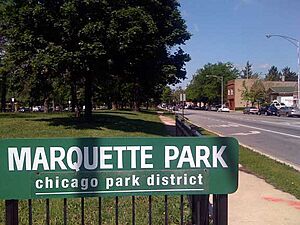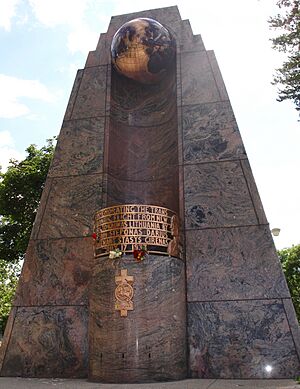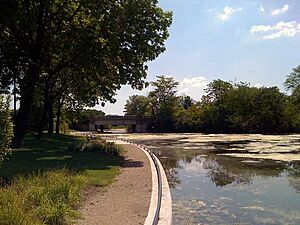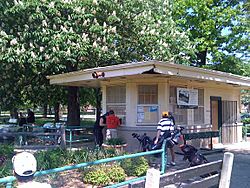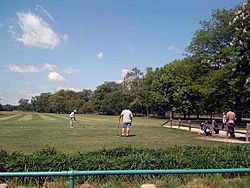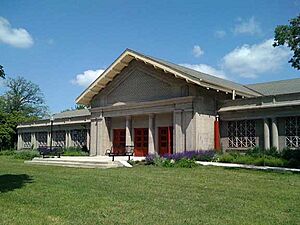Marquette Park (Chicago) facts for kids
Marquette Park is the biggest park on the southwest side of Chicago, Illinois. It covers about 323 acres (1.3 square kilometers)! You can find it in the city's Chicago Lawn neighborhood. The park is named after Father Jacques Marquette, a famous explorer (1637–1675).
Contents
Park History
How the Park Was Planned
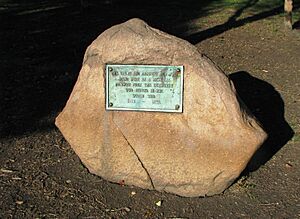
Marquette Park is one of 14 parks designed in 1903 by the Olmsted Brothers. At 323 acres, it was the largest of the new neighborhood parks created by the South Park Commission.
The park's first superintendent, J. Frank Foster, imagined these new parks as beautiful "breathing spaces." They would offer educational and social activities for people in busy neighborhoods. In 1899 and 1903, the state allowed park commissions to buy land for new parks. The South Park Commission opened 10 new parks in 1905. These parks soon inspired similar ones in other cities across the United States.
The first plans for Marquette Park included a golf course with islands and lagoons. They also planned indoor and outdoor gyms, swimming pools, playgrounds, gardens, and a concert area. Because the park was so big, building it took a long time. Some original ideas were changed due to problems with the land. Still, in 1913, an 18-hole golf course opened. By 1917, the park had playing fields, a playground, tennis courts, and a golf shelter.
In the early 1930s, the Great Depression caused money problems for many park districts. In 1934, 22 separate park groups joined together to form the Chicago Park District. After this, park workers updated the golf shelter, built restrooms, and added more walking paths.
Monuments in the Park
In 1935, a statue was placed in the park to honor Lithuanian-American aviators Steponas Darius and Stasys Girėnas. They died during a flight across the Atlantic Ocean in their plane, the Lituanica. You can find this statue in the northeast part of the park.
There is also a large granite rock monument in the northwest corner of the park. It remembers those from the area who served in World War I. A bronze plaque on the rock says: "This tablet and adjacent elm tree stand here as a memorial to those from this community who served in the World War 1914 - 1918."
Important Protests at the Park
Marquette Park and its surrounding neighborhood became known for some important, but sometimes difficult, gatherings between the 1960s and 1980s.
Civil Rights Marches
In 1966, Dr. Martin Luther King Jr. and the Southern Christian Leadership Conference decided to bring their peaceful protests to Chicago. During the Chicago Freedom Movement, Dr. King led a group of marchers into neighborhoods near Marquette Park. These areas were mostly white at the time.
About 4,000 Marquette Park residents gathered to watch the march. Some people threw bottles, bricks, and rocks at the marchers. One rock hit Dr. King on the head, but he was not badly hurt and continued the march.
This event was part of the Chicago Freedom Movement, which Dr. King helped lead. It was a year-long effort to achieve "open housing." This meant that everyone, no matter their race, should be able to buy or rent homes without fear. The march did not achieve all that Dr. King had hoped for. An agreement was made with Chicago Mayor Richard J. Daley, but promises about fair housing were not kept.
In 2016, a memorial honoring Dr. Martin Luther King Jr. was built in the park.
Other Protests
In the 1970s, a group called the National Socialist Party of America held demonstrations in the park. The Chicago Park District tried to stop them. The group then wanted to march in Skokie, a town with many Jewish residents. A court decision said the march had to be allowed because of the First Amendment, which protects free speech.
To avoid a difficult situation, the ACLU helped make a deal. The group would not march in Skokie. Instead, Chicago would let them return to Marquette Park for their demonstration.
Plane Crash Near the Park
On December 8, 1972, a plane called United Airlines Flight 553 crashed two blocks west of Marquette Park. It landed in a neighborhood, sadly killing 43 people on board and two on the ground. The plane was a Boeing 737-222. It was trying to land at Midway Airport. The crash was blamed on pilot error. There were eighteen survivors, including all three flight attendants. Among those who died were a congressman, George W. Collins, and a news reporter, Michele Clark.
Park Features and Surroundings
Ashburn Prairie
Marquette Park has a very special area called the Ashburn Prairie. It's about three and a half acres in size. This prairie has an amazing story!
It started as a small, untouched patch of native plants near 87th Street and Kedzie Avenue. This prairie had almost 100 different kinds of native plants. These included beautiful flowers like Mountain Mint, Nodding Wild Onion, Purple Coneflower, and Black-eyed Susan. It also had tall grasses like Big Bluestem and Indian grass.
When land development threatened this rare prairie, the Park District and many people worked together to save it. In the spring of 1993, the Park District carefully dug up large sections of the prairie using a special tree spade. These sections were four to five feet wide! With the important roots still attached, crews carefully moved these huge sections to Marquette Park. They drilled holes and placed the sections near the park's lagoon. Luckily, the soil at the new spot was similar to the old one. The prairie rescue was a success! Most of the flowers bloomed in their new home the very first year.
Volunteers continue to care for the prairie today. They plant new seeds, add more plants, and remove weeds. Ashburn Prairie is a great example of how people can work together to protect nature. You can find the prairie along the edge of the lagoon, south of Mann Street and east of Kedzie Avenue.
Golf Course
The Marquette Park Golf Course is a fun nine-hole course. It's about 3,187 yards long and has elevated tees and greens. Water is part of the game on seven of the nine holes! The golf course also has practice areas. These include a driving range, a large putting green, and areas for chipping and sand bunkers. Billy Casper Golf manages this course, along with all other Chicago Park District golf places.
Tarkington Elementary School
Tarkington Elementary School is located on the south side of Marquette Park. It serves students from pre-kindergarten through 8th grade. The school was finished in 2005.
Tarkington is special because it was the first school in the Chicago Public Schools system to get LEED certification. This means it was built using environmentally friendly methods. The school building is about 134,000 square feet and sits on a 9.82-acre site. It was built to help with crowded schools in the Southwest Side and can teach up to 1,000 elementary students.
The two-story school has classrooms for art, music, and science. It also has a kitchen, dining areas, a multipurpose room, and a field house. The field house is shared with the Chicago Park District. The project also improved Marquette Park by adding a new soccer field.
Park Facilities
Marquette Park offers many great facilities for everyone to enjoy:
- Competitive Cheerleading
- Basketball team
- Auditoriums
- Baseball fields
- Basketball Courts
- Community Garden
- Golf Course
- Gyms
- Meeting Rooms/Assembly Halls
- Men's and/or Women's Locker Rooms/Showers
- Parking Lots
- Paths for Jogging, Walking, and Bicycling
- Soccer Fields (home to Marquette F.C.)
- Tennis Courts


